Click to Download the PDF
Download the Word Doc
President’s Message
The time is flying by, the leaves are off the trees, and the clocks will be set back by the time you read this. My first year as president of the Georgina Historical Society has flown by, and I must credit our excellent board of directors for bearing with me as I stumbled through. Monthly meetings, volunteering at the Georgina Pioneer Village, working with other board members at the Sutton Farmer’s Market, and Harvestfest has made this a memorable year. I am looking forward to what next year will bring.
The Annual General Meeting is also rapidly closing in. As you must know by now, Wednesday November 22 is the date, and this year our speaker is from the Sharon Temple in East Gwillimbury. The title of the presentation is “Silence, Schism, Songs, and the Story of the Sharon Temple”, and will explore the Quaker roots of the Children of Peace. The Sutton Legion will be hosting our evening, and a roast beef supper is included in our price of $25 a plate. Unfortunately, tickets will not be available at the door as we need to give the Legion a set number for dinners beforehand. Tickets are available by emailing us at georginahistoricalsociety@outlook.com. I am looking forward to seeing you at the AGM, it should be great evening.
This is also when we do our elections, so if you want to be more involved in your community, please contact any board member and we’ll be happy to put your name in for nomination to the board.
I will also mention that we are taking a break for Christmas, so your next newsletter will be January.
Best of wishes in the upcoming holiday season,
Paul Brady
10 Quick Facts on… Remembrance Day
- Remembrance Day was first observed in 1919 throughout the British Commonwealth. It was originally called “Armistice Day” to commemorate armistice agreement that ended the First World War on Monday, November 11, 1918, at 11 a.m.—on the eleventh hour of the eleventh day of the eleventh month.
- From 1921 to 1930, Armistice Day was held on the Monday of the week in which November 11 fell. In 1931, Alan Neill, Member of Parliament for Comox–Alberni, introduced a bill to observe Armistice Day only on November 11. Passed by the House of Commons, the bill also changed the name to “Remembrance Day”. The first Remembrance Day was observed on November 11, 1931.
- Every year on November 11, Canadians pause in a moment of silence to honour and remember the men and women who have served, and continue to serve Canada during times of war, conflict and peace. We remember the more than 2,300,000 Canadians who have served throughout our nation’s history and the more than 118,000 who made the ultimate sacrifice.
- The poppy is the symbol of Remembrance Day. Replica poppies are sold by the Royal Canadian Legion to provide assistance to Veterans.
- Remembrance Day is a federal statutory holiday in Canada. It is also a statutory holiday in three territories (Yukon, Northwest Territories and Nunavut) and in six provinces (British Columbia, Alberta, Saskatchewan, New Brunswick, Prince Edward Island and Newfoundland and Labrador).
- The national ceremony is held at the National War Memorial in Ottawa. The Governor General of Canada presides over the ceremony. It is also attended by the Prime Minister, other government officials, representatives of Veterans’ organizations, diplomatic representatives, other dignitaries, Veterans as well as the general public.
- In advance of the ceremony, long columns of Veterans, Canadian Armed Forces members, RCMP officers, and cadets march to the memorial lead by a pipe band and a colour guard. At the end of the ceremony, they march away to officially close the ceremony.
- Some of the 54 Commonwealth member states, such as Canada, the United Kingdom and Australia, observe the tradition of Remembrance Day on the eleventh hour of the eleventh day of the eleventh month. Other nations observe a solemn day but at different dates. For example, ANZAC Day is observed in New Zealand on April 25. In South Africa, Poppy Day is marked on the Sunday that falls closest to November 11.
- Many nations that are not members of the Commonwealth also observe Remembrance Day on November 11, including France, Belgium and Poland.
- The United States used to commemorate Armistice Day on November 11. However, in 1954 they changed the name to Veterans Day.
Source: https://www.veterans.gc.ca/eng/remembrance/information-for/educators/quick-facts/remembrance-day
Why Remember?

Left: Canadians departing for active service in Europe during the Second World War, 1940.
(Library and Archives Canada C-38723)
“We must remember. If we do not, the sacrifice of those one hundred thousand Canadian lives will be meaningless. They died for us, for their homes and families and friends, for a collection of traditions they cherished and a future they believed in; they died for Canada. The meaning of their sacrifice rests with our collective national consciousness; our future is their monument. ”
Right: A Canadian soldier kneels at grave of fallen comrade in the United Nations Cemetery, Korea, April 1951. (Library and Archives Canada PA 128813)
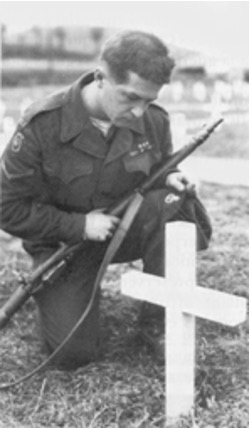
These wars touched the lives of Canadians of all ages, all races, all social classes. Fathers, sons, daughters, sweethearts: they were killed in action, they were wounded, and thousands who returned were forced to live the rest of their lives with the physical and mental scars of war. The people who stayed in Canada also served—in factories, in voluntary service organizations, wherever they were needed.
Yet for many of us, war is a phenomenon seen through the lens of a television camera or a journalist’s account of fighting in distant parts of the world. Our closest physical and emotional experience may be the discovery of wartime memorabilia in a family attic. But even items such as photographs, uniform badges, medals, and diaries can seem vague and unconnected to the life of their owner. For those of us born during peacetime, all wars seem far removed from our daily lives.
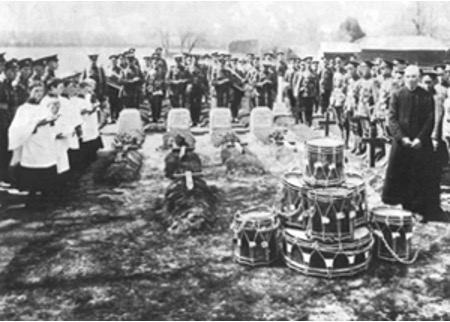
Left: Funeral service for Canadians at Bramshott during the First World War.
(Library and Archives Canada PA 4850)
We often take for granted our Canadian values and institutions, our freedom to participate in cultural and political events, and our right to live under a government of our choice. The Canadians who went off to war in distant lands went in the belief that the values and beliefs enjoyed by Canadians were being threatened. They truly believed that “Without freedom there can be no enduring peace and without peace no enduring freedom.”
By remembering their service and their sacrifice, we recognize the tradition of freedom these men and women fought to preserve. They believed that their actions in the present would make a significant difference for the future, but it is up to us to ensure that their dream of peace is realized. On Remembrance Day, we acknowledge the courage and sacrifice of those who served their country and acknowledge our responsibility to work for the peace they fought hard to achieve.
During times of war, individual acts of heroism occur frequently; only a few are ever recorded and receive official recognition. By remembering all who have served, we recognize their willingly-endured hardships and fears, taken upon themselves so that we could live in peace.
Source: https://www.veterans.gc.ca/eng/remembrance/history/a-day-of-remembrance/why
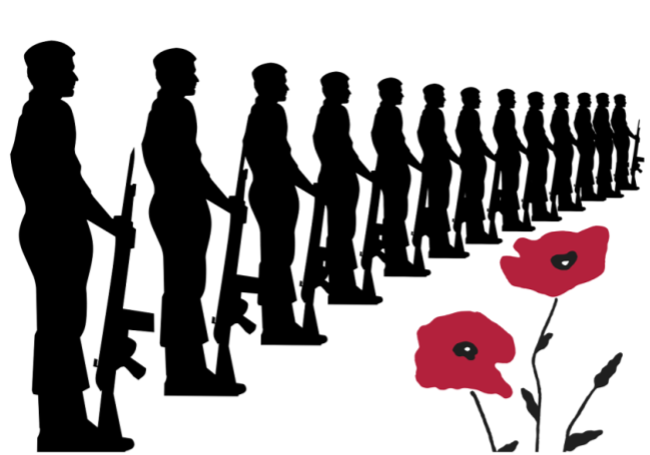
Pioneer Christmases…
The following article reminding us of Christmases past before it became so commercialized was found on the following website:
https://interestingcanadianhistory.wordpress.com/2014/12/19/pioneer-christmases/
The Christmas holiday in Canada has come a long way from the days of pioneer Canada. However, for though the tree wasn’t loaded with gifts, those small log cabins were filled with love.
Even though the Christmas tradition was well-established by the time Canada was settled by Europeans, early pioneers did not celebrate the holiday as we do today.
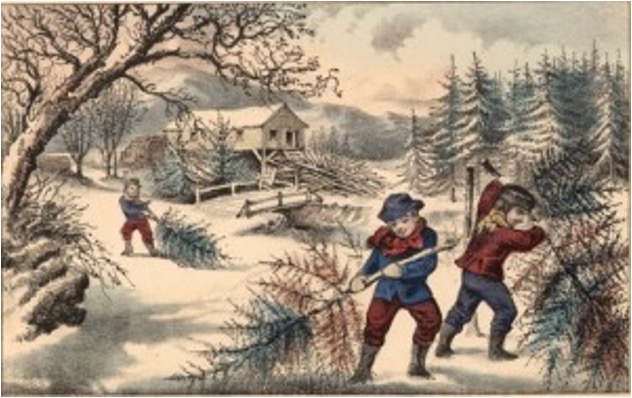
Most pioneer families did not put up a Christmas tree. Small log cabins held no space for such a frivolous item. Secondly, United Empire Loyalists were of English, Scottish, and Irish descent and the tradition of the Christmas tree did not originate in these countries.
Left: The joy of selecting a tree. It was a family ritual that taught compromise.
The Christmas tree came to Canada with settlers from Pennsylvania who were of German descent. The idea originated in that country. It was not until Queen Victoria’s husband, Prince Albert, introduced the Christmas tree to England that United Empire Loyalists in Canada took on the tradition.
British families had a custom of hanging greens. This was more appropriate in the cabins of Upper Canada. English greens consisted of ivy, mistletoe, and holly. These were not available in Canada during the winter months, so evergreen boughs were hung and made into garland. These garlands decorated mantles, stair banisters, and exterior doorframes.
Right: A typical Christmas kissing ball. It was an acceptable way of getting a smooch from the guy or girl you’ve had your eye on.
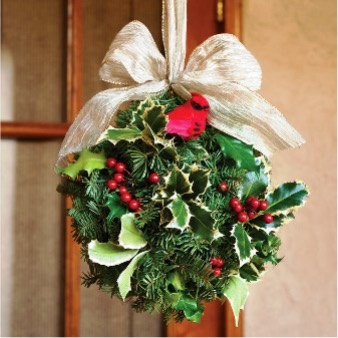
England had the Christmas tradition of the kissing ball. In Upper Canada, the kissing ball took a different form. A garland was woven into a hanging ball that hung from the rafters. This ball took the place of the Christmas tree.
All decorations were natural such as nuts, berries, feathers and pinecones. Cranberries and popcorn chains were made. Cranberries were plentiful in the bogs and Canada’s Native People’s had introduced popcorn. After a few years, calico bows, ribbon and lace were used. Children made figures out of straw and yarn to decorate the Christmas ball and garland. Cookie dough figurines and gingerbread men were not used to decorate the tree until after 1860.

Stockings were hung on the mantle or bedposts. If the harvest had been plentiful and the children well behaved, the stockings were filled with presents. A gingerbread man may have been included, but if so it would have been molded by hand. There were no cookie cutters, wrapping paper or cards.
Left: Hanging stocking by Christmas
Often, an apple was dropped into the stocking and possibly a treasured item such as a jack knife or cornhusk doll. Perhaps if someone in the family knew how to whittle, a wooden puzzle or figurine would be found. Wooden rocking horses were often made for small children. I once saw such a horse at an antique sale. The carver had hand-rubbed the contours of the horse to a smooth finish and had added a horse hair mane and tail. Then, he had painted eyes and a saddle. The horse was a magnificent specimen of early Canadian handcrafts.
Other toys given to children were such treasures as a homemade sled or snowshoes. These brought many hours of winter fun.
Children made gifts for their parents and siblings. Potpourri, sachet, and pomander balls were often given to both men and women. Handkerchiefs were hemmed and scarves, mittens and hats were knit. Girls as young as five-years-old could hem by hand and knit.
Right: How happy and proud a child would be to wake up to something like this. It may look rustic, but it was made with love.
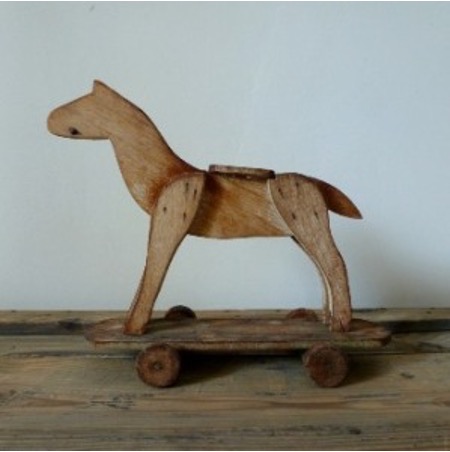
If there was a nearby town or trading post, often pennies would be saved to purchase a gift of pins, needles, thimbles, threads and a pin-cushion for the lady of the house. Duck down was collected all year to make pillows and cushions.
Candy was made as well as cookies. The candy was shaped into sticks or balls and was flavored with fruit juice and peppermint.
On Christmas morning the stockings were emptied and games of hide-the-thimble or blind-man’s bluff were played. Wild turkey or goose was most often served along with mincemeat pie and plum pudding made with hand gathered fruit. I can remember Grandma baking for days before Christmas, the smell of fruitcake, mincemeat pies, and currant pudding making her kitchen a most inviting place.
The 1800’s brought many changes to the Christmas tradition both in Canada and the world. In 1800, tree ornaments began to be manufactured in Europe. In 1822, Clement Moore wrote “A Visit From Saint Nicholas,” for his family. Today, we call it “The Night Before Christmas,” and children all over the world look forward to its telling.
There was no electricity in many parts of Canada as recent as the 1950’s. I remember as a small child, going to Grandma’s for Christmas. Grandma didn’t have hydro but she did have a beautiful tree. Usually, it was spruce. Fastened on the end of each branch by a silver clip were small red and white candles. Grandma had a mold and made these candles for the tree each year.
In 1896, the T. Eaton Company of Canada produced its first Christmas catalogue. I can remember waiting with eager anticipation for both the Eatons and Simpsons Christmas books. My siblings and I would pour over the pages until they were dog-eared and tattered, trying to make our choices. We were allowed to ask for only one thing. It was a difficult choice.
Eatons quit producing a Christmas catalogue many years ago. It saddened me to see them go. Many childhood memories are of Eaton’s where my aunt worked as a seamstress..
In 1905, the T. Eaton Company of Canada started a tradition. Santa Claus arrived by wagon at the store in downtown Toronto. Malls and department stories still continue to promote the arrival of Santa Claus.
Christmas has come a long way from the days of pioneer Canada and I often think we have forgotten the true meaning of the season. It is a time of giving and sharing. A time for families. A time to give of ourselves. Even though the tree wasn’t loaded with gifts, those small log cabins were filled with love.
Merry Christmas!
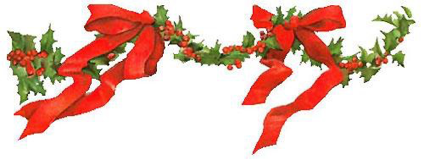
Where in Georgina?
Our last mystery location was identified correctly by Don Rae as the United Church in Virginia. Thanks Don! We ran the mystery location below for several months with no-one able to identify it. Let’s try again! What was it and where was it located?
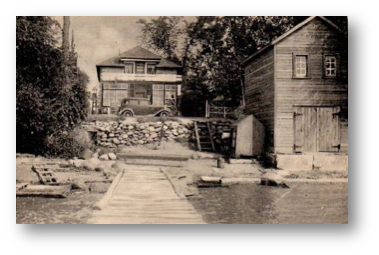
Our Pioneer Ancestors
Below is the listing for the village of Pefferlaw as found in Anderson’s Gazetteer and Directory for the Province of Ontario published by Robertson and Cook of Toronto in 1869. It gives the names of key individuals operating commercial enterprises that reside and work in and around the village.
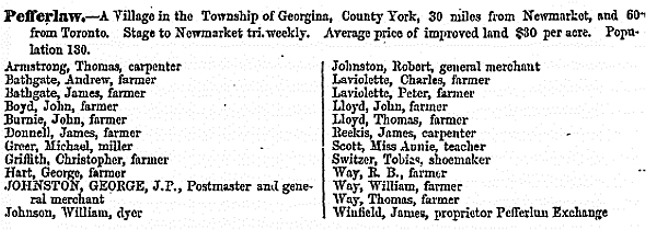
News
There’s a lot happening at the village. New and exciting programs and workshops are being offered all year long. Save this link to your desktop and check back regularly for updates, or email Melissa Matt at curator@georgina.ca. Digitization of the Archives will soon commence once the consultant report to the Town has been accepted and approved. It should go forward in two stages; first the actual process of digitization of the resource and second the determination of how the finished product will be made available. Volunteers will be needed for the Old Fashioned Christmas and Festival of Lights to help with refreshments and other duties. Contact Melissa Matt at curator@georgina.ca.
Volunteers wanted!!! Give any one of your board members a call if you are interested in getting involved. We would also like to know if any of our members would be interested in forming a group like Bradford’s Cemetery Guardians to engage with the Town of Georgina in the rehabilitation of our neglected pioneer cemeteries. Contact Paul Brady of any member of the Board for further information.
Our annual AGM will be held at the Sutton Legion. This year’s Annual General Meeting will be held on Wednesday, November 22. This is a perfect opportunity to meet your fellow members and enjoy a lovely dinner as a bonus. Our guest speakers are from the Sharon Temple Museum and will talk about the temple and the Children of Peace. There will also be a short business meeting for the annual report and the election of officers on the Board. Please note a slate of candidates will be presented to the membership and other nominations will be accepted from the floor for all open Board positions.
A reminder for all members; memberships fees for next year are due by the end of the year.
Events
November 6th – Board Meeting at the Quilter’s Cabin 2:00 pm.
November 22nd – Annual General Meeting, Sutton Legion…5:30 doors open for meet and greet, seating for dinner at 6:30. Dinner tickets $25.00 each; purchase no later than Nov. 7th so we can let the caterers know our numbers.
November 25th – Old fashioned Christmas and Festival of Lights at the Georgina Pioneer Village. Please note the buildings will not be open.
January 8th – Board meeting, location to be advised
January 16th – Bring and Brag, location to be determined
There will be no meetings or newsletter in December
